What You Need to Know About Eco-Friendly Wood Flooring
Eco-friendly wood flooring may make less of a difference for the environment than you’d think.
Here’s why.
Out of the many construction materials available, wood is already a sustainable choice.1 It stores carbon, making it one of the “most environmentally friendly flooring options.”2
But if you’re looking for an extra measure of assurance, the label “eco-friendly” can provide that. It helps you know that the wood for your flooring was harvested in a way that preserves the forest and its ecosystem, protects endangered species, and provides good working conditions. The flooring may also be lower in toxic chemicals, making it safer for your home, too.
As you decide what flooring type to put in, we’ve pulled together some important considerations. We’re going to dive into:
- Why sustainability matters for wood flooring
- What to consider when choosing eco-friendly flooring
- Eco-friendly wood flooring options
Why does sustainability matter with wood flooring?
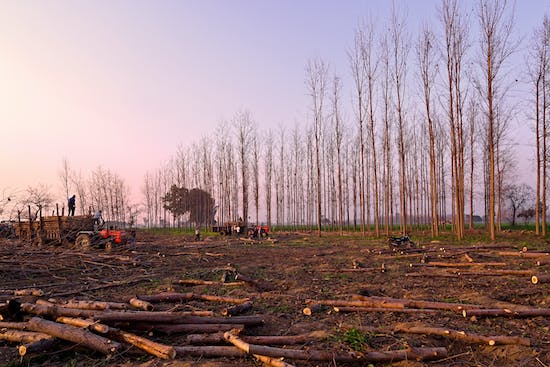 Wood itself is already a sustainable material with a low, or even negative, global warming potential.3 But various factors within its life cycle can impact the environment, such as harvesting methods, manufacturing, and transportation.
Wood itself is already a sustainable material with a low, or even negative, global warming potential.3 But various factors within its life cycle can impact the environment, such as harvesting methods, manufacturing, and transportation.
Choosing wood with sustainability certification makes it more likely to have been harvested with good practices that allow the forest to thrive. In this way, you support efforts to reduce humanity’s carbon footprint and prevent deforestation.
That’s a big deal, considering that “deforestation and forest degradation is the second leading cause of carbon pollution, causing 20% of total greenhouse gas emissions.”4
So, if you have a wood floor already, keep it. Have it refinished, but don’t replace it if you can help it. Quality wood flooring can last a long time when properly maintained. The National Wood Flooring Association points out the following:
“In the United States, the hardwood forests that provide flooring products are growing more than twice as fast as they are being harvested. Although it usually takes hardwood trees about 40 to 60 years to mature (depending on the species), wood flooring can last well beyond 100 years in service when properly maintained.”5
In other regions of the world, that growth-to-harvest ratio may not be the case, though—which is why careful consideration is important when purchasing wood flooring.
What to consider when choosing eco-friendly wood flooring
As we’ve already emphasized, wood is an eco-friendly product. The problem arises in how it’s harvested, manufactured, transported, used, and disposed of. Out of concern, you might opt for an “eco-friendly” alternative, but here’s the deal: it may not be more eco-friendly than solid hardwood when you factor everything into the equation.
For example, you might choose engineered wood flooring since it uses only a small amount of hardwood for the veneer.
But you also have to consider that engineered flooring requires more manufacturing, resulting in a greater impact on the environment. It also may not be as durable as a wood floor, so it’ll end up in a landfill, where it doesn’t biodegrade because of its synthetic resins.
Let’s walk through some of these important factors to think about when picking eco-friendly flooring.
Certifications
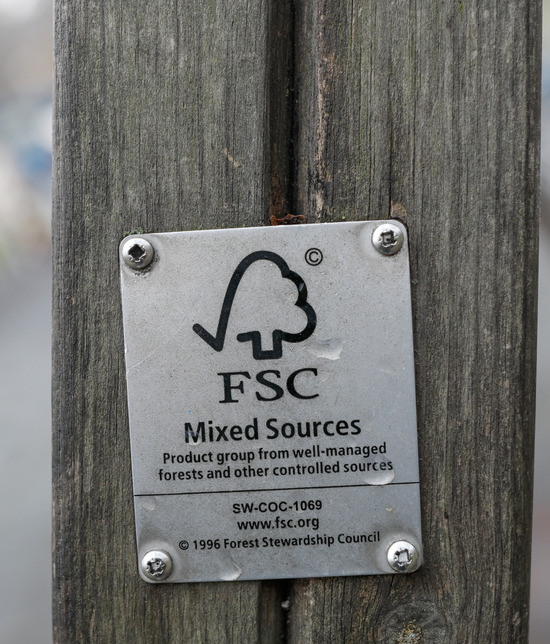 To get an idea of whether your flooring material is eco-friendly or not, look for certifications that show the wood comes from a sustainable source.
To get an idea of whether your flooring material is eco-friendly or not, look for certifications that show the wood comes from a sustainable source.
One of the most well-known certifications—and perhaps most stringent—is one by the Forest Stewardship Council (FSC). The FSC is a non-profit organization with specific criteria to ensure responsibly managed and harvested forests.
The criteria include measures to6:
- Preserve rare old-growth forests
- Prevent deforestation
- Protect water quality
- Prohibit toxic chemicals or pesticides
- Harvest responsibly
- Protect endangered species
A note of caution, though: just because you see the FSC label doesn’t mean all of the flooring is FSC-certified. This is often the case with labels like “FSC Mixed Sources” or “Made with FSC Certified Wood.”
Instead, look for “100% FSC Certified.”
Aside from the FSC, some other US certifications include:
- The American Tree Farm System (ATFS)—This network of 74,000 farmers in the US helps support smaller-scale forest owners in farming sustainably.
- Sustainable Forestry Initiative (SFI)—This certification is for paper and wood products from sustainably managed forests.
If you’re concerned about air quality and the off-gassing of chemicals from your floor, you’ll also want to look for certifications that limit toxins, such as formaldehyde, in flooring. Here are a few options:
- Greenguard Gold
- CARB2
- FloorScore
Certifications, though, are not the end-all-be-all.
We’ll look at other things that can help you determine whether a flooring type is sustainable.
The wood origin
 Where your wood flooring comes from can make a big difference in how it was harvested.
Where your wood flooring comes from can make a big difference in how it was harvested.
Illegal logging and deforestation are big issues in South America, the Caribbean, and Southeast Asia. A lot of the resulting wood gets imported as products into Europe and North America.7
The moral of the story?
Be cautious about where your wood comes from. If the seller can’t tell you, that’s a red flag in and of itself.
In general, flooring from domestically sourced wood will be much more sustainable because it doesn’t have to be transported long distances. A life cycle assessment of hardwood lumber points out that “the impacts of lumber transportation contribute a significant part to the overall [environmental] impact of delivered hardwood lumber.”8
Another consideration is the manufacturing process of the flooring you’ve chosen. You may not be able to find out the specifics, but a general idea of how different types of flooring are manufactured can help you in your decision-making.
For example, engineered wood flooring will require much more manufacturing than solid hardwood flooring.
On the flip side, there’s coconut palm flooring, which is very sustainable because all the waste in the manufacturing process is biodegradable.
Durability
 Durability is the question of how long a floor will last and how well it will withstand large amounts of use. The longer a floor can last without being completely replaced and put in a landfill, the better for sustainability.
Durability is the question of how long a floor will last and how well it will withstand large amounts of use. The longer a floor can last without being completely replaced and put in a landfill, the better for sustainability.
Hardwood floors, as noted earlier, can last a lifetime if cared for properly, but that isn’t necessarily the case with their eco-friendly alternatives.
Some people opt for flooring from softwood trees (such as pine or Douglas fir), thinking that softwood is more sustainable because it grows so quickly. Here’s what they could be missing, though:
Softwood doesn’t hold up well to a lot of use. It can get dented and damaged much more easily, so if they install this floor in a high-traffic area, it may need replacing much sooner than a hardwood floor.
The right type of finish can offset this durability issue, but flooring finishes also pose some concerns we’re going to explore next.
VOCs
VOCs, or volatile organic compounds, are potentially harmful toxins to humans that can show up in flooring materials, such as finishes, adhesives, and binders. After a floor installation, they off-gas, affecting indoor air quality.
On the milder side, they can cause reactions like headaches, irritation in the eyes, nose, or throat, and dizziness. On the more serious side, they could even contribute to cancer.9
Avoiding them is the best option.
When it comes to adhesives, look for water-based adhesives that state they are low-VOC or VOC-free. Specifically, avoid urea-formaldehyde adhesives, which are common in products manufactured in China.10
Bamboo often has adhesives and finishes with formaldehyde,11 so be especially cautious with the type you choose.
Also, look for non-toxic finishes for your floor or choose a factory-finished product to avoid the fumes that come from finishing the floor on-site.12
Disposability
Disposal is the final step in the life cycle of a flooring product. How well can your flooring be disposed of?
Wood, thankfully, is biodegradable if it ends up in a landfill. But better than that, it can also be recycled. (We don’t recommend burning, though, since wood flooring can release chemicals depending on the type of finish.)
The same isn’t necessarily true for some of its “eco-friendly” alternatives. Engineered flooring, as we mentioned, won’t biodegrade well because of its synthetic parts. But natural materials like bamboo, palm coconut wood, or reclaimed wood flooring typically do.
Moisture content and moisture resistance
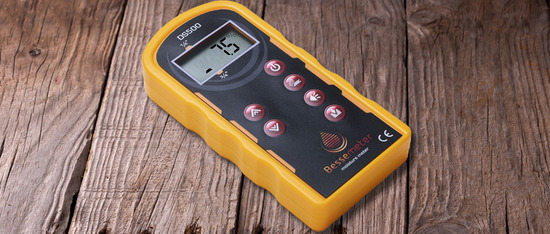 Moisture affects wood flooring, whether hardwood, softwood, reclaimed wood, or engineered wood. And any serious moisture damage could ruin your floor and cut its life cycle short.
Moisture affects wood flooring, whether hardwood, softwood, reclaimed wood, or engineered wood. And any serious moisture damage could ruin your floor and cut its life cycle short.
Of course, some flooring types will have greater resistance to moisture than others, making them better for climates where moisture could be an issue.
Regardless of flooring type, though, the key is to make sure the wood is at the proper moisture content when it is installed. You or the flooring installer will need a wood moisture meter to test the moisture content and check that the flooring matches the moisture content of the environment. Then, once the floor is in, seek to keep it at a consistent temperature and relative humidity.
This way, you’ll avoid cupping or buckling that could result in the floor needing to be replaced—and put in the landfill—much sooner than necessary.
Eco-friendly flooring options
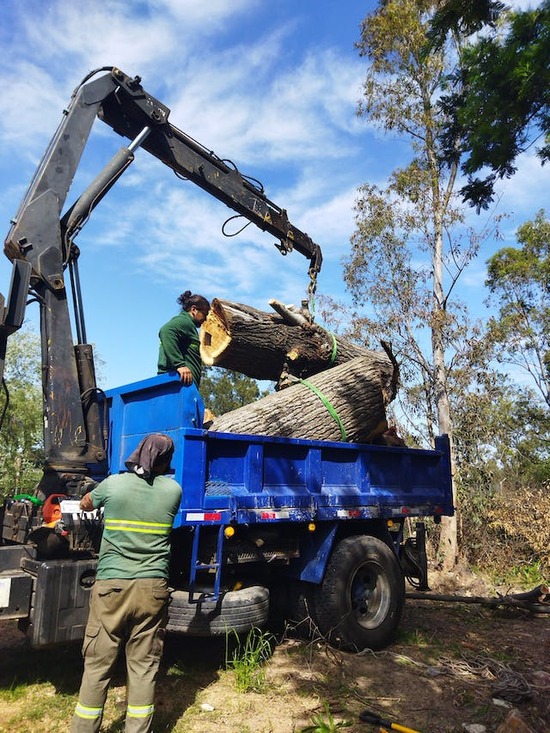 You have many options for sustainable wood flooring. A lot of hardwood flooring can be eco-friendly, depending on how they’ve been sourced, manufactured, and transported. And as you’ll notice, sometimes supposedly sustainable flooring options may not meet those claims.
You have many options for sustainable wood flooring. A lot of hardwood flooring can be eco-friendly, depending on how they’ve been sourced, manufactured, and transported. And as you’ll notice, sometimes supposedly sustainable flooring options may not meet those claims.
Let’s evaluate some of the pros and cons. We’ll start by looking at hardwood options.
Sustainable hardwoods
Some of the top sustainable hardwoods are:
- Maple
- Black cherry
- Oak
Hardwood is particularly durable, lasting even up to 100 years or longer!
To be sure that it’s been harvested responsibly, look for one of the certifications we’ve mentioned, such as FSC, or find out more about the origin of the wood.
Certain softwoods
Softwoods, unlike hardwoods, grow from coniferous trees and tend to have less dense wood. They grow much more quickly than hardwoods, making them a good renewable source.
Some common species for flooring are:
- Pine
- Douglas fir
- Red cedar
Softwoods can make for a very beautiful floor, but the downside is that they don’t handle harder treatment well. They tend to show dents and damage easily, so they may need to be refinished or replaced much sooner than hardwood floors.
For that reason, softwood flooring isn’t ideal for a high-traffic area, but it might work great for a gently used room.
Reclaimed wood
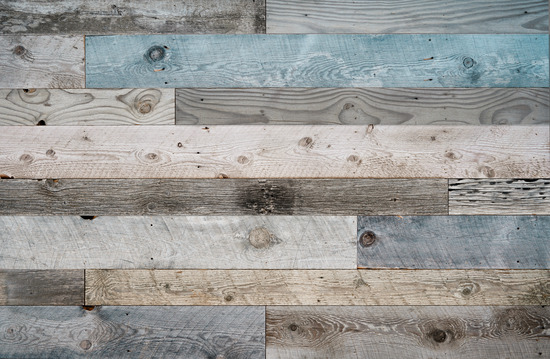 Reclaimed wood flooring is one of the most sustainable options available. It’s recycled from other projects like barns, old buildings, and fences, meaning you can provide that wood with another life. Often, the wood is a high-quality and durable species like oak.
Reclaimed wood flooring is one of the most sustainable options available. It’s recycled from other projects like barns, old buildings, and fences, meaning you can provide that wood with another life. Often, the wood is a high-quality and durable species like oak.
And reclaimed flooring has so much character.
Here’s what Kevin Minton, owner of Speciality Flooring in Ridgeland, South Carolina, said about it:
“One type of flooring that never gets boring for me…is reclaimed flooring. Every one of these floors has its own character; you’re giving people a truly one-of-a-kind floor.”13
You will need to consider a few things with reclaimed flooring, though.
For one, be aware that it can be a little more costly because of the work required to manufacture the flooring.
Second, make sure you’re getting it from a reputable company that has properly kiln-dried, processed, and milled the wood.
And finally, find out the source. Is it from old barns or buildings? Or is it from pallet lumber? Tommy Sancic, owner of Olde Wood Ltd. Company, gives this advice:
“Know the source of your material and whether it was originally harvested from an old-growth forest. We have seen floors sold as being reclaimed from barns and century-old structures that appear to actually be produced from recycled pallet lumber.”14
Engineered wood
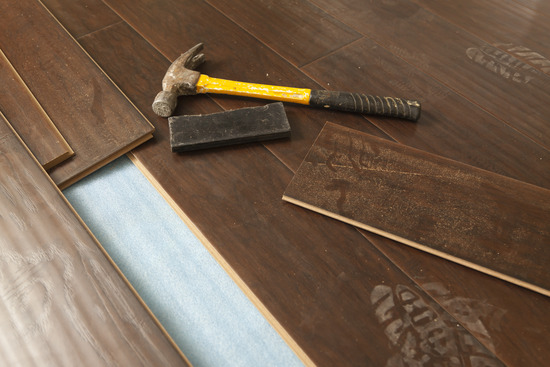 Engineered wood flooring consists of a hardwood veneer with a core made of plywood, OSB, or fiberboard. As a result, it requires less hardwood—which could help save trees.
Engineered wood flooring consists of a hardwood veneer with a core made of plywood, OSB, or fiberboard. As a result, it requires less hardwood—which could help save trees.
Could is the key word here.
Research done on the life cycle of engineered wood indicates that it may or may not be sustainable, depending on numerous factors.
One of those is the type of core used. If the core comes from wood waste, as it does with fiberboard, it’ll be more sustainable than a core made from solid logs, like plywood is.
Another factor is manufacturing. This process can have a higher carbon footprint because of how the core has to be processed and adhered to the veneer.
Third, transportation can make the flooring less eco-friendly if the wood is sourced and/or manufactured overseas.
Finally, engineered flooring may not last as long as other types of flooring, namely because it can’t be refinished as often. This is particularly the case if it has a thin veneer (less than 3mm), so look for a floor with at least a 3–6mm veneer.15
A potential concern with engineered flooring is the adhesives used for assembling it. Many, especially those from China, contain formaldehyde-based adhesives.
Cork
The material for cork flooring comes from the bark of the cork oak tree rather than the tree itself. Once the cork tree is mature, it can be harvested of its bark about every 9–12 years.16 This quality makes it an excellent renewable resource.
Since cork is a softer material, it needs something underneath, like a plywood substrate, to help provide it structure.17 Being a softer material means that it has a greater tendency to be damaged, too. It’s sensitive to moisture and can show water stains. It can also fade if exposed to sunlight.18
As a result, you’ll want to consider how your use of it could affect its longevity. It’s probably not ideal for high-traffic areas in a home.
Another consideration with cork is the adhesive used to bind the flooring together. Look for one that’s low or free of VOCs.
Bamboo
 Bamboo is technically a grass rather than a wood. Its ability to grow quickly makes it another great sustainable flooring option.
Bamboo is technically a grass rather than a wood. Its ability to grow quickly makes it another great sustainable flooring option.
Bamboo is an incredibly hard substance. It consists of fiber bundles that are very durable. However, the tissue between these bundles is weak, meaning that bamboo can still become damaged more easily than many hardwoods. Dan Harrington, a product specialist for Galleher Hardwood Co. and an NWFA instructor, notes:
“Avoid using traditional bamboo in demanding settings where you have high traffic, big dogs, etc. It’s really just not as hard as the Janka test results indicate.”19
Strand woven bamboo is a little more durable because the bamboo strands are compressed together (similar to OSB). However, this type of bamboo is susceptible to moisture issues like cracking and cupping. For this reason, Harrington adds:
“Be sure to thoroughly acclimate and carefully measure the moisture content of strand bamboo before installation. You might be surprised how long it takes to acclimate properly.”20
Bamboo flooring quality is something else to watch out for. Price is a big indicator of quality,21 so don’t look for the cheapest option available; otherwise, you might end up with a poor-quality product in the long run.
As a last note, bamboo flooring often comes from China, where there is less regulation of VOCs, so be vigilant about finding an option that is low in VOCs.22
Coconut palm wood
Coconut palm wood, when harvested responsibly, comes from coconut palms that no longer produce coconuts. Thus, it has the potential to be a very sustainable flooring option. What’s more, growing, manufacturing, and using palm flooring are all very sustainable processes, and the wood is even biodegradable at the end of its life cycle.23
On top of that, palm wood makes for very durable flooring. Its hardness has been compared to mahogany—without the expensive price tag.24
The biggest sustainability concern with palm wood flooring is transportation. Since these palms usually grow in the tropics, they often have to be transported overseas. Pay attention to the origin of the flooring and look for ones that have been sustainably certified.
Sustainability goes beyond flooring choice
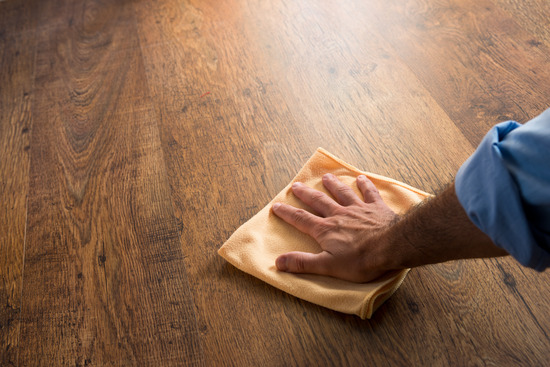 Eco-friendly or not?
Eco-friendly or not?
As we’ve seen, it’s not as straightforward as we’d like it to be. Many factors play into the sustainability of flooring—regardless of whether it’s hardwood, softwood, reclaimed wood, engineered wood, or some other alternative.
That’s why, once you’ve done your research and purchased your flooring, proper installation and care can make such a big difference. Regardless of whether the floor is labeled “eco-friendly,” having to repair and replace it soon after installation isn’t eco-friendly. And it’s not friendly to your wallet or time, either.
Protecting your floor—particularly from its number-one problem, moisture damage—can ensure that your floor lasts as long as it was meant to. In this way, you’ll live a more sustainable lifestyle and save yourself the hassle of unnecessary repairs and replacements.
That sounds like a win-win!
- “Construction Material Pyramid,” Royal Danish Accademy’s Center for Industrialised Architecture. (↑)
- “Environmental Benefits,” National Wood Flooring Association. (↑)
- “Construction Material Pyramid.” (↑)
- “Why Forests Matter,” FSC. (↑)
- “Environmental Benefits.” (↑)
- “Advantages of FSC,” FSC. (↑)
- Ritchie, Hannah, “Deforestation and Forest Loss,” Our World in Data; “Illegal Logging in Latin America and Caribbean Inflicting Irreversible Damage,” INTERPOL. (↑)
- “Life Cycle Assessment of Rough-Sawn Kiln-Dried Hardwood Lumber,” PE International. (↑)
- “UL GREENGUARD Certification,” UL Solutions. (↑)
- “Choosing Healthy Building Materials,” Health House Institute. (↑)
- Ibid. (↑)
- Matthews, Leigh, “The Most Important Certifications for Ethical Hardwood Flooring,” LeafScore. (↑)
- Minton, Kevin, “What I’ve Learned Working with Reclaimed Wood Flooring,” Wood Floor Business. (↑)
- Sancic, Tommy, “Reclaimed Realities: What to Expect from Reclaimed Wood Flooring,” Wood Floor Business. (↑)
- “What’s Wear Go to Do with It? Quality Engineered Hardwood Is a Value-Add,” Floor Trends & Installation. (↑)
- “Cork Oak,” Rainforest Alliance. (↑)
- Jewell, Don, “Know These 10 Facts for a Great Cork Job,” Wood Floor Business. (↑)
- “Cork Flooring Pros and Cons,” America’s Floor Source. (↑)
- Harrington, Dan, “Beyond Bamboo Basics: Gain a Deeper Understanding of This Flooring,” Wood Floor Business. (↑)
- Ibid. (↑)
- Ibid. (↑)
- Harrington, Dan, “Know These Facts Before Working with Bamboo Flooring,” Wood Floor Business. (↑)
- Nguyen, Quynh, “How Sustainable Is Coconut Wood? Here Are the Facts,” Impactful Ninja. (↑)
- “Coconut Palm,” Sustainable Materials. (↑)
